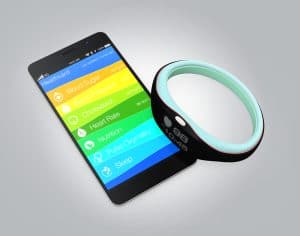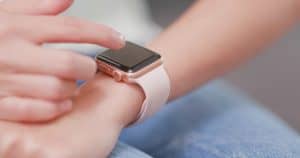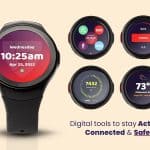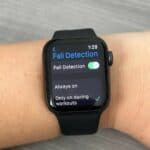
Often paired with an app, wearable devices can help users determine how to improve their health through habits and monitoring.
Today, technology has fully invaded the healthcare space. While technology was always a part of the healthcare experience, only recently have we seen the innovation spread beyond diagnostic devices in hospitals or electronic medical records in physician offices. Today, you can find diagnostic devices on the wrists or fingers of people at your work, on your train, or in your home.
Medical wearables have stormed onto the scene in the past 5-10 years, and the industry shows no sign of stopping any time soon. Here is what you can expect when it comes to the future of medical wearables.
Medical Wearables
A medical wearable is any type of device that a person wears on their body and that can collect information about that person. In a hospital or acute care setting, medical wearables transmit the information it collects to the clinicians on the patient’s care team. This allows the team to determine any safety risks as well as to produce a personalized treatment plan.
However, medical wearables are no longer just for hospital or acute care settings. In fact, if you have a watch that counts your steps or physical activity, you are wearing a medical wearable right now.
Medical wearables have transitioned out of the hospital and into your local Target store, where you can purchase watches and rings that monitor everything from your daily movement to your sleep quality to your blood oxygen levels. Thanks to a variety of tiny sensors, your watch can now tell you about your heart rhythm, which you can pass along to your physician during your next appointment.
Popular types of mainstream medical wearables include:
- Apple Watch (Series 7 launched in October 2021)
- Fitbit
- Whoop
- Oura ring
Whether you are new to wearable medical technology or are a more experienced user looking toward what might be on the horizon, you can keep your eye out for more advances coming in the next few years.
Features

Woman use of smart watch
Currently, medical wearables have a variety of features that can help with preventative care, peace of mind, or even gathering information to help determine a future plan of care. Depending on the wearable and system, you might find capabilities that include:
- EKG monitoring
- Alerting for irregular heart rhythm
- Blood oxygen level monitoring
- Sleep quality and quantity monitoring
- Healthy habit tracking
- Hydration tracking
- Exercise or step count tracking
- Pulse monitoring
- Calorie intake
- Inactivity tracking
- Muscle recovery
- Resting heart rate tracking
- Body temperature tracking
- Respiratory rate
- Fall detection tracking
All of this information, when gathered and run through an algorithm, can tell you and your care team about how your body is functioning. Users can learn more about their strengths and weaknesses, as well as use the information to shape their healthy habits moving forward.
As for the future features, medical wearables are developing and users might soon be able to pick up a watch or ring that can:
- Anticipate medical emergencies before they happen
- Direct interface between the wearable and the user’s physician office
- Monitor and detect hypertension
- Observe and report blood flow hemodynamics
- Determine lung volume and fluid
- Anticipate health risks of users
- Observe and report range of motion
Beyond the Watch or Ring
Perhaps the biggest innovation in medical wearables coming in the next few years is expanding beyond the traditional watch or ring. Top Medtech companies are finding ways to incorporate wearable technology into clothing, shoes, socks, and ear-worn devices. The hope is that these items can provide an even easier way to monitor medical information and progress, as well as to gather even more data.
Medtech companies are also looking at making wearable technology even smaller. The “invisibles” trend is making it seem possible for small data collection devices to be inserted under the skin or even in a particular part of the body. For example, a patient with a heart concern might end up with a wearable technology sensor in their pulmonary artery that gathers and transmits real-time data to their physician.
Benefits
Medical wearables have been a part of the hospital experience for decades, starting with finger pulse oximeters and Holter monitors. The benefit of having a device on you for extended periods of time that measures certain health outcomes is that a physician or other clinician gets a broader view of what is happening in your daily life as opposed to just 20 minutes during an office visit.
Thanks to medical wearable technology advancing and becoming more available to people outside of physicians, users can now learn more about how their body works. Benefits of knowing about the body’s habits and functioning can include:
- Decreased rates of obesity
- Increased healthy activity
- Increased attention to sleep habits and quality
- Peace of mind when it comes to health concerns
- Better recovery after strenuous exercise
- Better recovery after a concussion, surgery, or procedure
- Decreased risk of falling
- Know when to call the physician for a follow-up appointment
- Better preventative care
- Increased communication between the user and their physician
- Empowerment to manage chronic conditions or diseases
- Patients are engaged with their own health and take ownership of their habits
- Alerts when something is wrong can make users seek treatment before a crisis occurs
- Data is collected in real-time, which means physicians get access to that real-time data
Of course, there are some drawbacks to using medical wearable technology for some patients. For example, some patients can find monitoring their own technology reports to be overwhelming or even anxiety-producing. It can also lead to obsessive habits or disordered thinking, especially when it comes to exercise or eating. There are also concerns about privacy and how to report information to physicians in a confidential manner.
However, most patients and technology users tend to enjoy features provided on their wearable watch, ring, or other devices.
Value
The medical wearable market has just started to grow quickly over the past five years. It’s expected to continue to grow as users become even more familiar with the technology and as physicians begin using the data collected from these devices more readily during preventative care or check-ups. In fact, many physicians are starting to prescribe certain medical wearable devices to users who could benefit from the data collection and tracking, which will only drive up sales in the future.
Currently, the projections for medical wearable devices in 2022 are hovering at more than $14 billion. To compare, the industry was making only $6 billion just five years ago. One thing is certain: medical wearable technology is not going anywhere.
If you haven’t found a way to incorporate medical wearables into your daily life yet, now could be the perfect time to speak with your physician about it. You’ll be surprised at how quickly you pick up the technology and how much you use the device as well as the app that will help you track your health trends or meet your health goals.
Here’s to an exciting future full of new ways for medical wearables to keep users healthier, happier, and more rested. Read our Medical Guardian reviews to see how medical wearables compare to a traditional medical alert system opiton.


